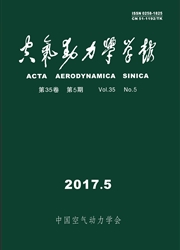

 中文摘要:
中文摘要:
采用“亚跨超CFD软件平台”(TRIP)数值模拟了梯形翼全展长高升力构型,主要目的是考察湍流模型对高升力构型气动特性的影响。相应的风洞试验是1998年在NASAAmes12英尺增压风洞中完成的。本文采用一方程和两方程湍流模型,数值模拟了全展长高升力构型的气动特性并给出了典型站位的压力分布。研究表明,与修正后的试验数据相比较,在定常可收敛的迎角范围内,两种湍流模型得到的气动力系数和压力分布与试验结果吻合较好,SA一方程湍流模型的计算结果更接近试验值;迎角大于19.19°后,襟翼后缘的较大范围分离是导致采用SST模型不能得到收敛的气动特性的主要原因。
 英文摘要:
英文摘要:
The complex flow over trap wing is computed using CFD software TRIP(TRI sonic Platform), the present study is part of TRIP validation effort for the capacity of numerical simulation of three-dimension high lift device. The corresponding test had been accomplished in NASA Ames 12' PWT in 1998, aerody- namic characteristics and pressure distribution were summarized. The SA turbulence models and ROE differ- ence scheme are adopted to simulate "full span" and "part span" high lift configurations, multi-grid technique and parallel technique are applied to accelerate convergence. The numerical aerodynamic characters are in good agreement with corrected experiment data before stall; for both configuration, the computed pressure distributions for the typical case are in good agreement.
 同期刊论文项目
同期刊论文项目
 同项目期刊论文
同项目期刊论文
 期刊信息
期刊信息
